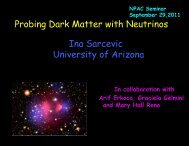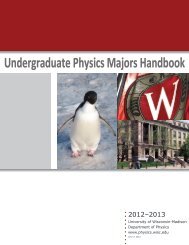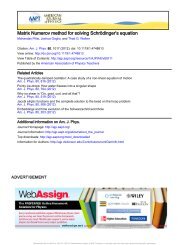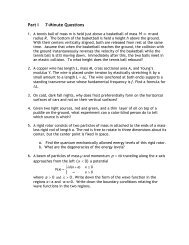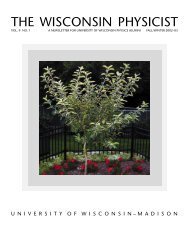Multilayer dielectric structure for enhancement of evanescent waves
Multilayer dielectric structure for enhancement of evanescent waves
Multilayer dielectric structure for enhancement of evanescent waves
You also want an ePaper? Increase the reach of your titles
YUMPU automatically turns print PDFs into web optimized ePapers that Google loves.
<strong>Multilayer</strong> <strong>dielectric</strong> <strong>structure</strong> <strong>for</strong><br />
<strong>enhancement</strong> <strong>of</strong> <strong>evanescent</strong> <strong>waves</strong><br />
Renée C. Nesnidal and Thad G. Walker<br />
We describe a type <strong>of</strong> multilayer <strong>dielectric</strong> coating designed to enhance the intensity <strong>of</strong> <strong>evanescent</strong><br />
<strong>waves</strong>. The coating consists <strong>of</strong> a stack <strong>of</strong> alternating high- and low-index quarter-wave layers followed<br />
by a final low-index layer whose thickness is chosen to optimize the <strong>evanescent</strong>-wave intensity.<br />
Indirect measurements <strong>of</strong> the film properties are in good agreement with theory.<br />
Key words: Evanescent <strong>waves</strong>, thin films, atom optics. r 1996 Optical Society <strong>of</strong> America<br />
The authors are with the Department <strong>of</strong> Physics, University <strong>of</strong><br />
Wisconsin-Madison, Madison, Wisconsin 53706.<br />
Received 8 August 1995; revised manuscript received 20 December<br />
1996.<br />
0003-6935@96@132226-04$10.00@0<br />
r 1996 Optical Society <strong>of</strong> America<br />
1. Introduction<br />
We introduce a type <strong>of</strong> multilayer <strong>dielectric</strong> coating<br />
designed to enhance the intensity <strong>of</strong> <strong>evanescent</strong><br />
<strong>waves</strong>. Recently there has been considerable interest<br />
in the use <strong>of</strong> <strong>evanescent</strong> <strong>waves</strong> <strong>for</strong> atom optics, 1<br />
<strong>for</strong> nonlinear optics, 2 and as sensitive optical sensors. 3<br />
In atom optics, <strong>evanescent</strong>-wave mirrors show promise<br />
<strong>for</strong> achieving atomic Fabry–Pérot cavities. 4 To<br />
maintain the atomic coherence on reflection from the<br />
mirror, it is essential to minimize spontaneous emission.<br />
For this reason it is best to use high-intensity<br />
<strong>evanescent</strong> <strong>waves</strong> tuned far from the atomic resonance<br />
frequencies. Similarly, in nonlinear optics it<br />
is desirable that the <strong>evanescent</strong>-wave intensity be as<br />
large as possible <strong>for</strong> maximum conversion efficiency.<br />
For sensors based on detecting the index <strong>of</strong> refraction,<br />
high-intensity <strong>evanescent</strong> <strong>waves</strong> can provide<br />
increased sensitivity. In addition, the sensitivity <strong>of</strong><br />
fluorescence detection sensors using <strong>evanescent</strong><br />
<strong>waves</strong> can also be improved with higher intensities.<br />
Enhanced <strong>evanescent</strong> <strong>waves</strong> have been produced<br />
by a variety <strong>of</strong> techniques. The confinement <strong>of</strong> light<br />
in optical waveguides, <strong>for</strong> example, produces highintensity<br />
<strong>evanescent</strong> <strong>waves</strong> <strong>for</strong> light that is resonantly<br />
coupled to one <strong>of</strong> the modes <strong>of</strong> the waveguide.<br />
Esslinger et al. produced enhanced <strong>evanescent</strong> <strong>waves</strong><br />
by using surface plasmons. 5 In addition, total internal<br />
reflection inside one <strong>of</strong> the elements in a laser<br />
cavity can also create <strong>enhancement</strong>. 6 Recently, Kaiser<br />
et al. 7 demonstrated a method <strong>for</strong> coupling into<br />
an optical waveguide through optical tunneling<br />
through a <strong>dielectric</strong> gap. They demonstrated <strong>evanescent</strong>-wave<br />
intensities that were more than 100<br />
times the intensity produced from total internal<br />
reflection 1TIR2 at a prism–air interface. This technique<br />
<strong>for</strong> creating enhanced <strong>evanescent</strong> <strong>waves</strong> has<br />
been used to reflect metastable argon atoms with<br />
incident velocities as high as 3 m@s. 8 More recently,<br />
they have demonstrated <strong>enhancement</strong> factors <strong>of</strong><br />
more than 1000. 9 This method has the additional<br />
advantage over standard waveguide coupling that<br />
the coupling is well controlled, and there<strong>for</strong>e the<br />
intensity <strong>of</strong> the <strong>evanescent</strong> wave is well understood.<br />
We present a new multilayer <strong>dielectric</strong> film <strong>for</strong><br />
<strong>enhancement</strong> <strong>of</strong> <strong>evanescent</strong> <strong>waves</strong>. This film can<br />
be understood as a Fabry–Pérot cavity in which one<br />
<strong>of</strong> the two mirrors is a TIR interface. The film<br />
<strong>structure</strong>, illustrated in Fig. 1, consists <strong>of</strong> a series <strong>of</strong><br />
2M 1 1 alternating high and low index <strong>of</strong> refraction<br />
quarter-wave <strong>dielectric</strong> layers plus one additional<br />
low-index layer. The thickness <strong>of</strong> this additional<br />
layer is chosen to maximize the intensity <strong>of</strong> the<br />
<strong>evanescent</strong> wave at the TIR interface. To characterize<br />
the film, we measured the relative phase shift <strong>of</strong><br />
reflected light as a function <strong>of</strong> incident angle. We<br />
demonstrate here an <strong>enhancement</strong> factor <strong>of</strong> 100, but<br />
<strong>enhancement</strong> factors <strong>of</strong> more than 1000 should be<br />
readily attainable.<br />
2. Theory<br />
The behavior <strong>of</strong> the film can be understood with<br />
standard methods <strong>for</strong> describing the propagation <strong>of</strong><br />
light in <strong>dielectric</strong> layers. 10 Referring to Fig. 1, we<br />
consider TE-polarized light incident from the substrate<br />
to the film at angle u s . Similar results can<br />
easily be obtained <strong>for</strong> TM light as well. The evanes-<br />
2226 APPLIED OPTICS @ Vol. 35, No. 13 @ 1 May 1996
Fig. 1. Dielectric <strong>structure</strong> <strong>for</strong> <strong>enhancement</strong> <strong>of</strong> <strong>evanescent</strong>-wave<br />
intensities. The layers labeled H indicate the high-index 1n 5 2.32<br />
TiO 2 layers, and the layers labeled L indicate the low-index<br />
1n 5 1.4542 SiO 2 layers. The laser light is incident on the film<br />
<strong>structure</strong> from the substrate at an angle u s . An <strong>evanescent</strong> wave<br />
is produced from TIR at the vacuum interface; the <strong>structure</strong> is<br />
designed to maximize the intensity <strong>of</strong> the <strong>evanescent</strong> wave.<br />
cent wave has an imaginary propagation vector<br />
whose y component is ibv@c 5 iv@c1n s2 sin 2 u s 2 12 1@2 ,<br />
where v is the frequency <strong>of</strong> the incident light, n s is<br />
the substrate index <strong>of</strong> refraction, and c is the speed <strong>of</strong><br />
light. We define a particular incident angle in the<br />
substrate, which we call the design angle, <strong>for</strong> which<br />
all the layers except the final one are exactly quarterwave.<br />
At this angle the fields, E x and B z , at the TIR<br />
interface are given in terms <strong>of</strong> the incident electric<br />
field E i by<br />
1 E x<br />
B z<br />
2 1 5 tE i<br />
ibtE i<br />
2 1 5 a<br />
ic<br />
1a ib<br />
ic d 2 5 1<br />
ib<br />
d 25 E i31 1 E i Y s 31 2 exp1iµ246 , 112<br />
21<br />
cos f iY L sin f<br />
iY L sin f cos f 2<br />
0 i12Y<br />
3<br />
3<br />
L 2 M M11<br />
@Y H<br />
iY M11 H @12Y L 2 M 0 4 . 122<br />
Here t is the transmission coefficient, Y L 5 n L cos u L ,<br />
Y H 5 n H cos u H , Y S 5 n S cos u S , µ is the phase shift on<br />
TIR, and f52psY L @l, where s is the thickness <strong>of</strong> the<br />
last layer and l is the wavelength <strong>of</strong> the incident<br />
light. Solving Eq. 112, we find that the transmission<br />
coefficient is<br />
where T 0 is the transmission without the coating.<br />
It is clear that T diverges as Y L = 0, i.e., as the<br />
incident angle in the prism approaches the critical<br />
angle <strong>for</strong> propagation in the low-index layers.<br />
When the incident angle differs from the design<br />
angle, the <strong>enhancement</strong> factor decreases. As a function<br />
<strong>of</strong> angle the <strong>enhancement</strong> factor has a narrow<br />
resonance shape, with the width <strong>of</strong> the resonance<br />
depending on the size <strong>of</strong> the peak <strong>enhancement</strong><br />
factor. Larger <strong>enhancement</strong> factors lead to narrower<br />
widths.<br />
3. Experiment<br />
We chose to demonstrate the <strong>evanescent</strong>-wave<br />
buildup with the parameter M 5 2 at a propagation<br />
angle 1in the substrate2 <strong>of</strong> 50°. A commercial coating<br />
laboratory used ion-assisted electron-beam vapor<br />
deposition to coat a superpolished fused silica<br />
window with alternating layers <strong>of</strong> SiO 2 1n 5 1.452<br />
and TiO 2 1n 5 2.32. Under these conditions the <strong>enhancement</strong><br />
is maximized <strong>for</strong> a final layer thickness<br />
<strong>of</strong> 1.30 l@4. This gives a theoretical intensity <strong>enhancement</strong><br />
<strong>of</strong> 100. The accuracy <strong>of</strong> the <strong>enhancement</strong><br />
factor is related to several parameters <strong>of</strong> the<br />
film, such as the errors in the thicknesses <strong>of</strong> the<br />
layers and the amount <strong>of</strong> scatter from surface roughness.<br />
A schematic <strong>of</strong> the apparatus used to examine the<br />
characteristics <strong>of</strong> the film is shown in Fig. 2. The<br />
coated window was attached to the hypotenuse <strong>of</strong> a<br />
fused silica right-angle prism with index-matching<br />
fluid to couple the light into the film. To test the<br />
film, we per<strong>for</strong>med ellipticity measurements on<br />
785-nm laser light that was linearly polarized at 45°<br />
to the z axis and reflected from the prism. The<br />
ellipticity was determined by measuring the maximum<br />
and minimum intensities <strong>of</strong> light transmitted<br />
through a rotatable polarizer. These measurements<br />
as a function <strong>of</strong> incident angle are shown in<br />
Fig. 31a2. The solid curve was obtained by solving<br />
the thin-film equations similar to Eq. 112 but generalized<br />
to arbitrary incident angles, polarizations, and<br />
film thicknesses. A least-squares optimization <strong>of</strong><br />
the film thicknesses produced the following results:<br />
t 5<br />
2Y s<br />
Y s 1d 1bb21i1ba2c2 . 132<br />
Maximization <strong>of</strong> the transmitted intensity, T ; 0t0 2 ,<br />
results when tan f52Y L @b. For convenience we<br />
define an <strong>evanescent</strong>-wave <strong>enhancement</strong> factor as<br />
the ratio <strong>of</strong> the <strong>evanescent</strong>-wave intensities with and<br />
without the coating. When T is maximized, this<br />
<strong>enhancement</strong> is<br />
T<br />
5 Y H 2M12 1n S2 2 12<br />
, 142<br />
T<br />
2M 0 Y L Y S2 1n L2 2 12<br />
Fig. 2. Schematic <strong>of</strong> the apparatus used <strong>for</strong> measuring ellipticity<br />
and attenuation <strong>of</strong> a light wave by the film <strong>structure</strong>.<br />
1 May 1996 @ Vol. 35, No. 13 @ APPLIED OPTICS 2227
Fig. 3. Polarization measurements made as a function <strong>of</strong> the<br />
incident angle on linearly polarized light reflected from the<br />
<strong>dielectric</strong> <strong>structure</strong>: 1a2 ellipsometry measurements; 1b2 phase<br />
difference between TE and TM light shift deduced from 1a2 by<br />
removing the effects <strong>of</strong> the coupling prism.<br />
high-index layers 5 0.94 l@4, low-index layers 5<br />
1.04 l@4, and a final low-index layer 5 1.38 l@4.<br />
All these parameters are within the design tolerances<br />
specified by the coating laboratory.<br />
The ellipticity can alternatively be expressed in<br />
terms <strong>of</strong> the relative phase shift between the TE and<br />
TM polarizations f and the polarization angle u <strong>of</strong><br />
the light as R 5 1cos 2 2u1sin 2 2u cos 2 f2 1@2 . In<br />
addition we can measure f, and we can write u in<br />
terms <strong>of</strong> the transmission coefficients <strong>of</strong> the polarization<br />
components <strong>for</strong> the film. Manipulation <strong>of</strong> these<br />
expressions permits us to extract the relative phase<br />
shift in<strong>for</strong>mation from the ellipticity data. Figure<br />
31b2 shows the same ellipticity data in terms <strong>of</strong> this<br />
relative phase shift on TIR. The phase shift shows<br />
the behavior <strong>of</strong> the film with the uninteresting<br />
effects <strong>of</strong> the coupling prism removed.<br />
From our optimization we find an <strong>enhancement</strong><br />
factor <strong>of</strong> 77 6 17. The primary contributions to the<br />
uncertainty in this value are from the thicknesses <strong>of</strong><br />
the high-index layers as well as uncertainty in the<br />
index <strong>of</strong> refraction <strong>of</strong> the TiO 2 . The index <strong>of</strong> refraction<br />
<strong>of</strong> a particular material is <strong>of</strong>ten slightly different<br />
after deposition compared with the original material<br />
from the introduction <strong>of</strong> impurities and the disruption<br />
<strong>of</strong> the crystal <strong>structure</strong>. In future coatings we<br />
can reduce the uncertainty in the <strong>enhancement</strong><br />
factor with tighter tolerances <strong>for</strong> the thicknesses as<br />
well as having the index <strong>of</strong> refraction <strong>of</strong> the various<br />
layers measured during the deposition process.<br />
4. Discussion<br />
A useful figure <strong>of</strong> merit <strong>for</strong> such a coating <strong>structure</strong> is<br />
the transmission <strong>of</strong> the film T multiplied by the full<br />
width at half-maximum <strong>of</strong> the resonance Du. The<br />
figure <strong>of</strong> merit increases in general <strong>for</strong> the increasing<br />
design angle but decreases as the design angle<br />
approaches the critical angle. The design angle <strong>for</strong><br />
this coating was chosen so that the figure <strong>of</strong> merit<br />
was maximized, allowing <strong>for</strong> a large <strong>enhancement</strong><br />
factor as well as a reasonable angular acceptance <strong>for</strong><br />
the resonance. Our figure <strong>of</strong> merit is 75, which is<br />
comparable with that <strong>of</strong> Kaiser et al. 7<br />
An important issue is scattering from film surfaces.<br />
In atom optics experiments, <strong>for</strong> example, such scattering<br />
can cause excitation and thereby heating <strong>of</strong><br />
the atoms at distances far from the substrate.<br />
Because the <strong>evanescent</strong>-wave intensity is enhanced<br />
in our film, the scattering is enhanced as well.<br />
Thus high-quality films that minimize this scatter<br />
are desirable. The increase in scatter is readily<br />
observed with an IR viewer when the prism is angle<br />
tuned through resonance. The amount <strong>of</strong> scattering<br />
can be quantitatively determined by measuring<br />
the reflectivity <strong>of</strong> TE-polarized light as a function <strong>of</strong><br />
angle. We find a 1.5% reduction <strong>of</strong> the reflected<br />
light when the angle is tuned on resonance. To<br />
compare with theory, we simulate the effect <strong>of</strong> scattering<br />
by introducing modified Fresnel coefficients in<br />
the matrix <strong>for</strong>malism <strong>for</strong> the last layer. 11 Such a<br />
treatment has been used previously in multilayer<br />
semiconductor systems, <strong>for</strong> example. 12 By including<br />
scattering in our matrix method, we predict that<br />
an rms surface roughness <strong>of</strong> 0.5 nm would reproduce<br />
the observed 1.5% loss, in good agreement with the<br />
experimentally measured rms roughness <strong>of</strong> 0.34 nm.<br />
Our film has an unusual property that should<br />
reduce scattering losses compared with, <strong>for</strong> example,<br />
the design <strong>of</strong> Kaiser et al. This comes about because<br />
the intensity vanishes at the interface between<br />
the second-to-last and the last layers, as<br />
shown in Fig. 4. Because the scattering comes<br />
primarily from surface roughness, <strong>for</strong> a given roughness<br />
and <strong>evanescent</strong>-wave intensity the scattering<br />
from this film should be less than that in Ref. 7.<br />
The <strong>enhancement</strong> factor <strong>for</strong> our film can be increased<br />
by including additional pairs <strong>of</strong> quarterwave<br />
layers or by increasing the design angle <strong>for</strong><br />
future films, thereby changing the thickness <strong>of</strong> the<br />
final layer. The increase in <strong>enhancement</strong>, however,<br />
is limited in principle by the scattering in the film.<br />
Because the intensity is largest at the last surface,<br />
Fig. 4. Square <strong>of</strong> the electric field as a function <strong>of</strong> position inside<br />
the film at resonance.<br />
2228 APPLIED OPTICS @ Vol. 35, No. 13 @ 1 May 1996
we included surface roughness only <strong>for</strong> that surface<br />
in our analysis. Using a 0.5-nm surface roughness,<br />
we find that the <strong>enhancement</strong> has a maximum<br />
possible value <strong>of</strong> ,13,000. Such a film would be<br />
difficult to couple into because <strong>of</strong> a narrow acceptance<br />
angle <strong>of</strong> 0.0009°. Thus in practice the surface<br />
scattering is not the parameter that limits the<br />
<strong>enhancement</strong> factor. Instead, as the <strong>enhancement</strong><br />
factor increases, the diffraction-limited divergence <strong>of</strong><br />
the laser limits the <strong>evanescent</strong>-wave intensity. The<br />
scatter is still important, however, because it attenuates<br />
the laser beam. As mentioned above, such<br />
scatter is particularly undesirable <strong>for</strong> atom optics<br />
experiments.<br />
Another interesting aspect <strong>of</strong> our coating is that, if<br />
the enhanced TIR occurs in a gas <strong>of</strong> index n a instead<br />
<strong>of</strong> vacuum, the phase shift µ <strong>of</strong> the TE-polarized light<br />
is highly sensitive to the index <strong>of</strong> refraction <strong>of</strong> the<br />
gas. Because the TM phase shift hardly changes,<br />
the relative phase shift between the two polarizations<br />
is also sensitive to changes in the index. Near<br />
resonance, the sensitivity can be shown to be<br />
dµ<br />
dn a<br />
52 Tn a<br />
2Y s b<br />
For our film the value <strong>of</strong> T@2Y s b5336. This value<br />
can be increased further with films designed <strong>for</strong><br />
small b. Still, even with our film that was not<br />
optimized <strong>for</strong> phase sensitivity, it was easy to observe<br />
index fluctuations in the air at resonance.<br />
A film can also be made with an even number 2M<br />
<strong>of</strong> layers. In this case the transmission is maximized<br />
<strong>for</strong> tan f5b@Y H , and the <strong>enhancement</strong> factor<br />
is given by<br />
T<br />
5 Y H 2M12 1n S2 2 12<br />
. 162<br />
T 0 Y 2M L Y 2 S 1n 2 H 2 12<br />
This film has a higher intrinsic figure <strong>of</strong> merit,<br />
because it tends to give broader angular widths <strong>for</strong> a<br />
given value <strong>of</strong> T. It has the disadvantage, however,<br />
<strong>of</strong> increased scatter because the intensity is nonzero<br />
at the next-to-last interface.<br />
152<br />
5. Conclusion<br />
We have demonstrated a new multilayer thin-film<br />
design <strong>for</strong> <strong>enhancement</strong> <strong>of</strong> <strong>evanescent</strong> <strong>waves</strong> at TIR.<br />
This film should be attractive <strong>for</strong> use in a variety <strong>of</strong><br />
experiments.<br />
This research was carried out with the financial<br />
support <strong>of</strong> the National Science Foundation and the<br />
David and Lucile Packard Foundation.<br />
References<br />
1. C. S. Adams, M. Sigel, and J. Mlynek, ‘‘Atom optics,’’ Phys.<br />
Rep. 240, 143–210 119942.<br />
2. D. B. Ostrowsky and R. Reinisch, eds., Guided-Wave Nonlinear<br />
Optics 1Kluwer Academic, Dordrecht, 19922.<br />
3. S. Simhony, E. M. Kosower, and A. Katzir, ‘‘Novel attenuated<br />
total internal reflectance spectroscopic cell using infrared<br />
fibers <strong>for</strong> aqueous solutions,’’ Appl. Phys. Lett. 49, 253–254<br />
119862.<br />
4. H. Wallis, J. Dalibard, and C. Cohen-Tannoudji, ‘‘Trapping<br />
atoms in a gravitational cavity,’’ Appl. Phys. B 54, 407–419<br />
119922.<br />
5. T. Esslinger, M. Weidemüller, A. Hemmerich, and T. W.<br />
Hänsch, ‘‘Surface-plasmon mirror <strong>for</strong> atoms,’’ Opt. Lett. 18,<br />
450–452 119932.<br />
6. F. Bretenaker, A. Le Floch, and L. Dutriaux, ‘‘Direct measurement<br />
<strong>of</strong> the optical Goos–Hänchen effect in lasers,’’ Phys. Rev.<br />
Lett. 68, 931–933 119922.<br />
7. R. Kaiser, Y. Lévy, N. Vansteenkiste, A. Aspect, W. Seifert, D.<br />
Leipold, and J. Mlynek, ‘‘Resonant <strong>enhancement</strong> <strong>of</strong> <strong>evanescent</strong><br />
<strong>waves</strong> with a thin <strong>dielectric</strong> waveguide,’’ Opt. Commun.<br />
104, 234–240 119942.<br />
8. W. Seifert, R. Kaiser, A. Aspect, and J. Mlynek, ‘‘Reflection <strong>of</strong><br />
atoms from a <strong>dielectric</strong> wave guide,’’ Opt. Commun. 111,<br />
566–576 119942.<br />
9. G. Labeyrie, A. Landragin, J. Von Zanthier, R. Kaiser, N.<br />
Vansteenkiste, C. Westbrook, and A. Aspect, ‘‘Detailed study<br />
<strong>of</strong> a high finesse planar waveguide <strong>for</strong> <strong>evanescent</strong> wave<br />
atomic mirrors,’’ submitted to J. Eur. Opt. Soc.<br />
10. Z. Knittl, Optics <strong>of</strong> Thin Films, 1Wiley, London, 19762.<br />
11. J. Szczyrbowski and A. Czapla, ‘‘Optical absorption in d.c.<br />
sputtered InAs films,’’ Thin Solid Films 46, 127–137 119772.<br />
12. C. Mitsas and D. Siapkas, ‘‘Generalized matrix method <strong>for</strong><br />
analysis <strong>of</strong> coherent and incoherent reflectance and transmittance<br />
<strong>of</strong> multilayer <strong>structure</strong>s with rough surfaces, interfaces,<br />
and finite substrates,’’ Appl. Opt. 34, 1678–1683 119952.<br />
1 May 1996 @ Vol. 35, No. 13 @ APPLIED OPTICS 2229


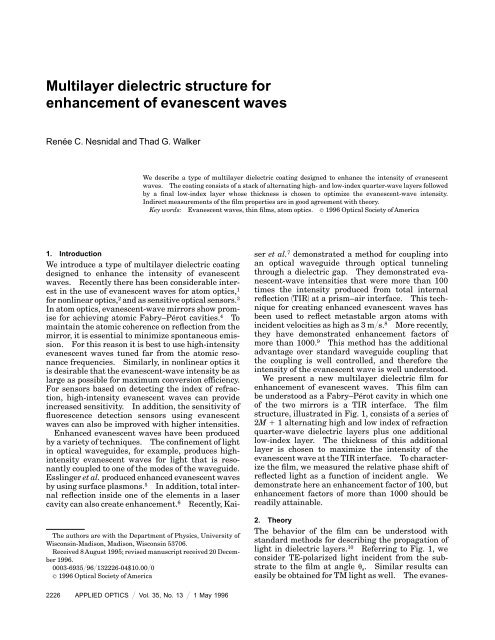

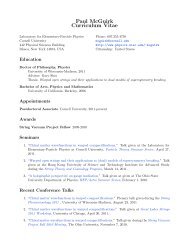
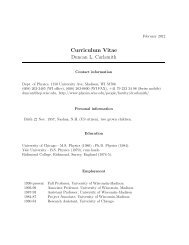
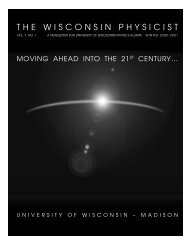


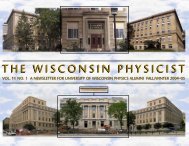
![The Symmetric Linear Potential [ ]](https://img.yumpu.com/25329322/1/190x245/the-symmetric-linear-potential-.jpg?quality=85)
